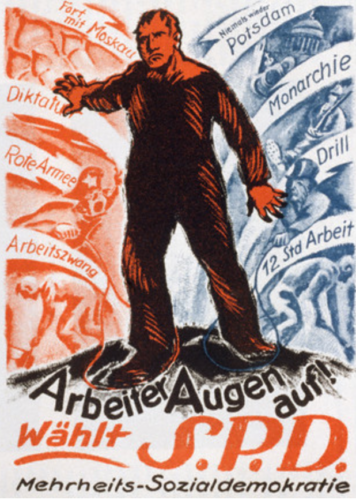At the time of Weimar, the Social Democratic Party (Sozialdemokratische Partei Deutschland, or SPD) was Germany’s oldest formally constituted political party. It began in 1875, primarily as a Marxist organisation, formed from the union of two workers’ parties. The newly formed SPD was able to quickly tap into a large supporter base of industrial workers and unionists. In the 1877 Reichstag elections SPD candidates received more than 500,000 votes and won 13 seats. Though these figures meant the SPD was a minor party and unable to influence policy, its rapid growth and increasing popularity alarmed the imperial government. In 1878 the German chancellor, Otto von Bismarck, promulgated the first of several Anti-Socialist Laws. Two failed attempts to assassinate Kaiser Wilhelm I in 1878 provided Bismarck with a pretext; he blamed the SPD and its Marxist ideology for fuelling revolution and terrorism. For much of the 1880s, the SPD was targeted by numerous police raids, individual arrests, surveillance and hostile government propaganda. Several militant unions were also targeted or broken up. Though the SPD continued to operate during this period, the party found it difficult to attract members or potential candidates for the Reichstag.
The SPD survived Bismarck’s suppression and by the late 1880s was again on the rise, fuelled by a revived union movement. By the 1890s the SPD – or at least its more public candidates – had adopted a more moderate political position, urging social democratic reforms rather than socialist revolution. The SPD embraced a number of causes beyond the conditions of workers, calling for improved rights for women and condemning the killing of natives by German colonials in Africa. The numbers of SPD candidates grew steadily during the 1890s and 1900s. By 1912, the SPD had more than a million members and was the largest party in the Reichstag. It began to assert influence on public policy, achieving improvements in education and healthcare, as well as better rights and conditions for industrial workers. The party also began to work with, rather than against Kaiser Wilhelm II’s government. In 1913 the SPD supported increased taxes that were necessary to fund the kaiser’s program of military expansion.
As is often the case in large political parties, the SPD’s main weakness was its ideological diversity. With more than a million members, the SPD housed a range of views from across the political spectrum. The party’s leadership were moderate socialists, committed to progressive reforms through democratic processes. August Bebel (the SPD’s founder and first leader) and Friedrich Ebert (Bebel’s successor) believed that socialist improvements could be won through parliamentary means, rather than violence or revolution. The SPD also had a right wing, comprised of liberals and centrists, and a radical left wing, containing hardline socialists and Marxists. The divisions within the party were generally manageable, though at times of controversy or crisis the SPD’s factions tended to turn on each other.
Stephen Lee, historian
These internal divisions were fatally exposed in 1914 when the Kaiser’s government declared war on France and Britain. The SPD’s radical left wing had taken a strong stance against the war, arguing that it was an unnecessary, aggressive and imperialistic action. These activists condemned both the war and the moderates in their own party, both inside and out of the Reichstag. Some were arrested and imprisoned by the government; by early 1917 most others had been expelled from the SPD. Some, like Rosa Luxemburg and Karl Liebknecht, instigated the Spartacist League that led an unsuccessful revolution in January 1919. Those who survived the German Revolution reformed as the Communist Party of Germany (KPD). The KPD loathed SPD leaders for their reliance on the right wing Freikorps and their alleged involvement in the murders of Luxemburg and Liebknecht. As a consequence the SPD and KPD never reconciled; they remained bitter rivals during the 1920s and early 1930s.
Until the rise of the NSDAP (Nazi) Party in the early 1930s, the SPD was the largest political party of the Weimar era. It was the only party to win more than 100 seats at every Reichstag election, beginning with 165 seats in January 1919. Despite its internal divisions and Germany’s political and economic woes, the SPD remained a strong and consistent supporter of the Weimar Republic and its constitution. The SPD was a major partner in all but one of the Weimar coalitions; SPD deputies sat in all Weimar era cabinets, three of them as chancellor (Philipp Scheidemann, Gustav Bauer and Hermann Muller). The party’s approach during the 1920s was moderate and conciliatory: it tried to walk the fine line between steady, conservative policies and progressive reforms, without really succeeding at either. By the early 1930s, the SPD had lost almost half of its voter base, most of them frustrated at the party’s inability to secure stable and lasting progress in Germany.

1. The SPD was originally a Marxist party, formed in Germany in 1875 from two workers’ groups.
2. In the 1880s the rapidly growing SPD was suppressed and persecuted by Bismarck’s Anti-Socialist Laws.
3. By the early 1900s, the core of the party had adopted moderate social-democratic ideas and policies.
4. It was split by its support for World War I, with the radical left wing breaking away to form the Spartacist League.
5. The SPD supported the Weimar Republic and was the largest single party for its duration, involved in almost all coalitions and cabinets.
© Alpha History 2014. Content on this page may not be republished or distributed without permission. For more information please refer to our Terms of Use.
This page was written by Jennifer Llewellyn, Jim Southey and Steve Thompson. To reference this page, use the following citation:
J. Llewellyn et al, “The Social Democratic Party (SPD)?”, Alpha History, 2014, accessed [today’s date], http://alphahistory.com/weimarrepublic/social-democratic-party-spd/.

